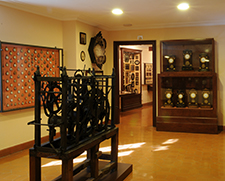Timepiece Hall (Hall 9)

Continuing with our tour of the 19th century and early 20th century, we come now to the gallery which features clocks from private homes. In keeping with the rest of the Collector's Cabinet, this collection is extremely diverse not only in sources, but in materials.
The great majority are wall clocks and table clocks. First we'll speak of the so-called Catalan "rat traps". The boxes of these wall clocks were made of pine wood and were decorated with chromolithographs. There are also German wall clocks here, which work using weights and pendula and can withstand 40 hours without being wound. Among popular clocks from France we find the grandfather clock, also known as the comtoise in a nod to its origins in the Franche-Comté region. Its white face is glazed and is decorated profusely not only on the pediment, but on the pendulum itself.
Most of these table clocks are French; all of them are characterized by decoration in the form of marquetry and gilded bronze.
The collection also brings together examples that incorporate certain pieces that move to the rhythm of time. Such is the case with the face with moving eyes, a boat and a violinist, among others.
We have left two historic clocks from Barcelona for last, not only because of their technical characteristics, but because of their legendary original locations. The first is found in the center of the room. This is the grand clock from the original Hospital de la Santa Creu i Sant Pau, made in 1732 by Emanuel Bofill. The second clock is from the Café de les "Set Portes" (or, Seven Doors). The café opened in 1838 and came to be one of the city's most luxurious establishments. It is still open to the public. This clock is hexagonal and has an alabaster face with glazed roman numerals.


